10 Best Day Trips from Merida
Merida is an awesome city, with something for everyone. Meandering through Merida’s vibrant streets and savoring its abundant culture is undeniably enchanting. We’ve lived in Merida for four years and love the mix of culture and history, but sometimes we want to see more. So let’s explore the best day trips from Merida.
We’ve lived in Merida for four years. One of the reasons, we find Merida such fun to live in is because of it’s location. By venturing beyond the city limits you can find a incredible variety picturesque cenotes, charming colonial towns, and breath taking natural wonders. There are even Mayan ruins near Merida.
Although there are no beaches in Merida, Progreso beach is an easy day trip.
Each of these day trips from Merida (except Rio Lagartos) is short enough to be possible in a morning or an afternoon. If you’re coming to the Yucatan Peninsula any time between March and November, I would suggest doing your trips in the morning. By mid-afternoon, it’s normally very hot!
Merida is surrounded by a network of excellent highways that make travel and navigation easy.
At last the Cancun to Merida Highway, which has been badly messed up for over two years as part of the Mayan train project, is now almost sorted out.
It’s now possible to drive to Cancun in about 4 hours. But is it possible to make a day trip to Merida from Cancun or the other way? Not really, unless you enjoy spending half of the day in your car.
So, let’s explore the best Merida day trips (it says 10 but I keep adding more!)
1. Progreso – the Seaside Town with Dinosaurs and a Pier
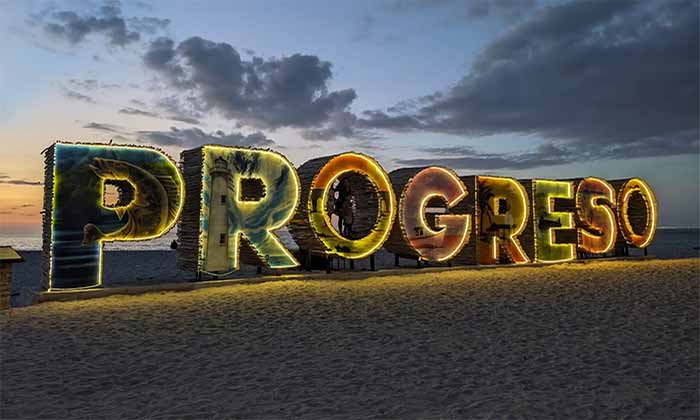
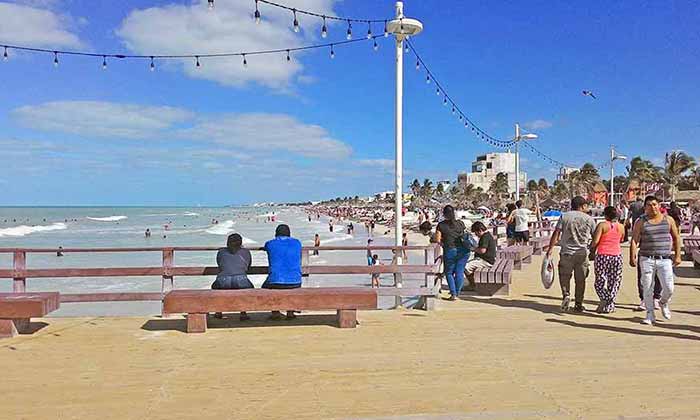
How far is Merida from the beach?
If you’re looking for the best beaches near Merida then visit Progreso. This is a seaside town about 27 miles (44km) from the city, along a highway. This makes it one of the easier day trips from Merida.
Aside from its sandy beach, the main attraction in Progreso is the Malecon. This boardwalk stretches 5 miles (7.5km) along the beachfront. The Malecon is lined with souvenir shops and restaurants, most of which have great views over the Gulf of Mexico. Some even have tables on the beach under palapas.
The wide range of restaurants cater to every taste and pocket, from tacos to expensive seafood. If you’re not fussed about the view of the Gulf, food in the streets further back is invariably cheaper.
Progreso’s pier is about 4 miles (6.5km) long, making it the longest maritime bridge in the world. It’s an unmissable landmark, easily visible from the beach.
The sea is relatively shallow for a long way from Progreso beach, with waters that are normally calm. They are not as clear as those of the Caribbean but there’s no sargassum seaweed to make swimming unpleasant.
If you’re keen on sea sports, you can find a variety of activities. Paddle boarding is popular, but Progreso is also known for great kitesurfing.
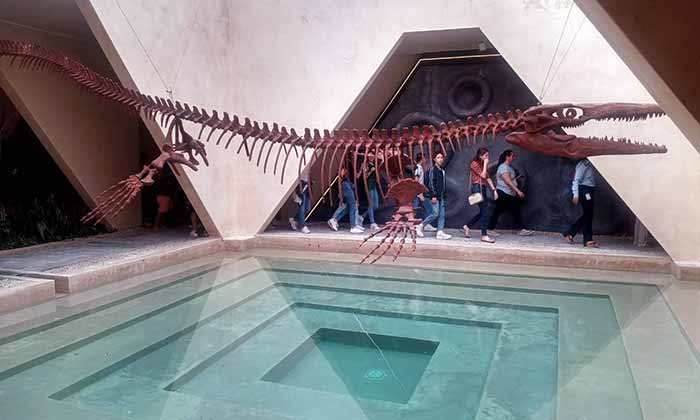
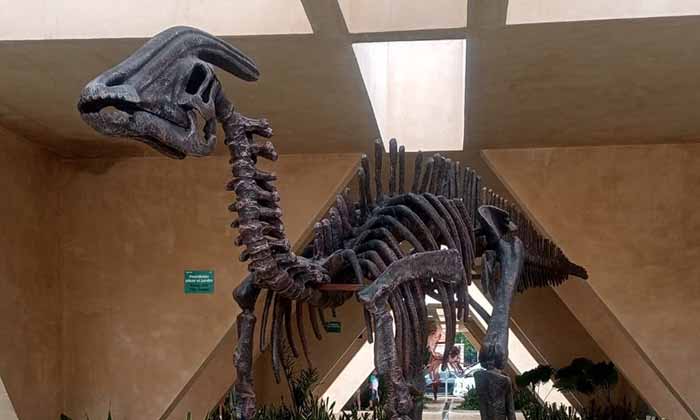
Progreso offers much more than sea and sand!
A 5-minute drive outside of Progreso is El Corchito Ecological Reserve. The reserve has mangrove swamps and three cenotes. It’s home to a variety of wildlife, such as raccoons, crocodiles, and beautiful birds, like flamingos.
According to scientists, 66 million years ago the massive Chicxulub asteroid hit the earth near Progreso. This worldwide catastrophe resulted in the extinction of dinosaurs. Details of this event can be found in El Museo del Meteorito, or The Meteorite Museum found along the Malecon. You can’t miss it as there are five life-size statues of dinosaurs next to the museum.
A little outside Progreso is Sendero Jurasico or the Jurassic Trail. This is a dinosaur-based theme park, great for the kids.
Other beaches near Merida include Sisal but it’s a bit further away.
Click Here to Find 16 Fun Things to do in Progreso or nearby
2. Campeche – Visit for History, Pirates, and great food!
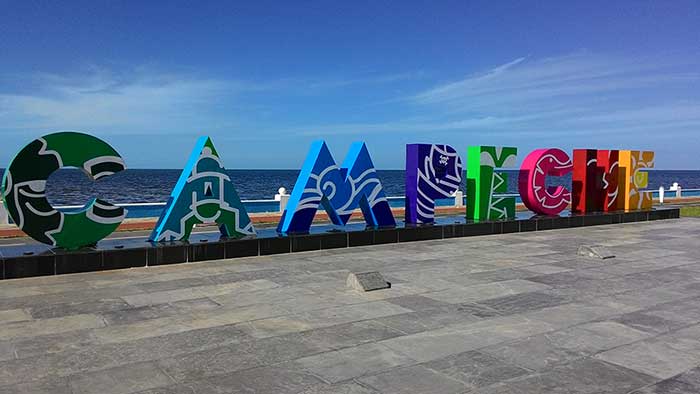
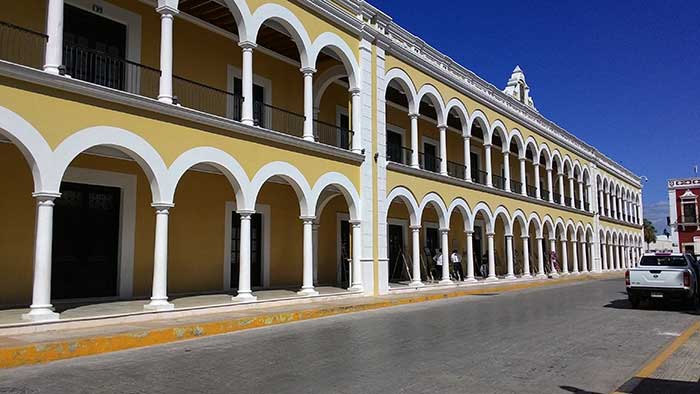
Campeche is one of the best day trips from Merida you can take!
Campeche is a fascinating city, packed with history – primarily about pirates! It’s our favorite city to visit in the Yucatan (we often stay overnight!). We have often undertaken a simple day trip from Merida to Campeche.
The old city of Campeche is a UNESCO World Heritage Site. The defenses that enclose the city have the original walls and fortifications in good repair. Walking along the top of the walls, complete with cannons, gives you a feel of what it was like 300 years ago.
Some of history’s most famous pirates have either lived in or attached Campeche, including Frances Drake, Henry Morgan, and El Olonés. You can visit the two forts built to ward off attacking pirates – Fuerte San Miguel and Fuerte San Jose el Alto.
Inside the walls of the city are many narrow roads, which offer great photo opportunities due to the colorful buildings. There is plenty of interesting shopping in the old city.
Near Calle 59 is Plaza de la Independencia, with its imposing Catedral de Nuestra Señora de la Inmaculada Concepción.
Campeche has a lovely Malecon, running just over 4 miles (7km) along the seafront. It is home to the famous Mayan Angel statue.
Looking for Great Campeche Food?
Calle 59 is the prime spot for tourists. No matter how times we visit Campeche, we always find ourselves back here for a drink or a snack. This is where the majority of tourist restaurants in Campeche are found. But that doesn’t mean they’re not good. We love eating here!
Wander up and down the road to compare prices as they vary considerably!
If you find the noise from the crowds a bit overwhelming, walk round the corner to Calle 57 to Santo Taquito. Their tacos are awesome and great value.
Campeche claims to have invented one of our favorite dishes – Camerones al Coco (jumbo shrimps in a coconut batter and deep fried). Campeche is also known for its dogfish dishes and octopus. Look out for Pulpo a Frances Drake!
A feature of old Campeche are the statues found in unexpected places. Outside a hotel in Calle 59 is a seated pirate, just waiting for you to take the perfect selfie!
Campeche to Merida is a comfortable 2-hour drive, mostly along a well-maintained highway. This makes it one of our ideal day trips from Merida.
Click here to find out ‘How to spend the perfect day in Campeche’
3. Homun – Don’t miss the center of the Ring of Cenotes
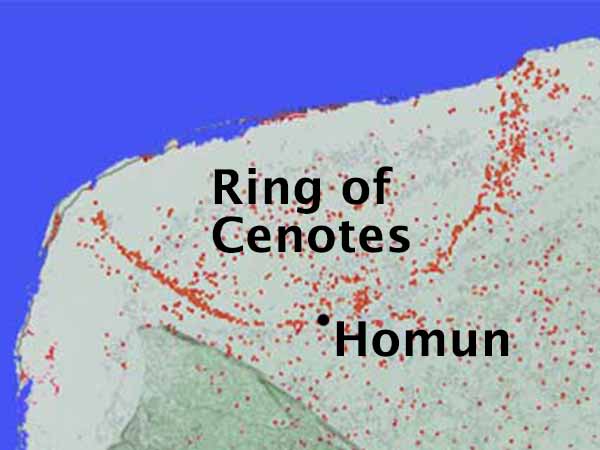
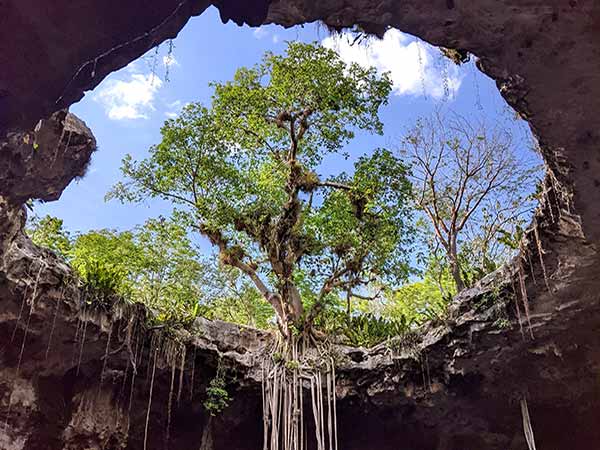
A drive from Merida of about an hour will bring you to Homun, a typical Yucatan village.
There is an interesting three-turreted church and an ex-convent in the town, both named after San Buenaventura. The story of this saint is unclear, with different versions told.
An annual festival takes place to commemorate San Buenaventura in July. There are various processions, dance contests, and other festivities which last several days. Aside from these festivities, the town itself probably isn’t worth visiting (with apologies to the friendly inhabitants).
The main reason people visit Homun on day trips from Merida is because it sits in the center of the Ring of Cenotes. The Ring of Cenotes contains at least 900 cenotes of differing sizes.
Of these around 20 cenotes are very close by and popular with tourists. The further you drive from Homun, the number of cenotes increases.
The one thing that abounds in Homun is the crowd of willing guides to help you choose a cenote! Even several miles outside the town, hopeful guides line the roadside, often on mopeds, to offer their services. They carry books of photos, pricing, and a lot of enthusiasm for their cenotes.
Many of the cenotes are close enough to each other that you can comfortably visit four or five in a single visit.
The top 20 cenotes around Homun are:
- Cenote Yaxbacaltun
- Candelaria Grotto
- Cenote Tza ujun kat
- Santa Rosa Cenote
- Cenote Pool Uinic
- Santa Cruz Cenote
- Cenote San Antonio
- Hool Kosom Cenote
- Chulul Cenote
- Chelpak Cenote
- Bal Mil cenote
- Cenote Canunchen
- Cenote of the Kampepén hacienda
- Cenote Kixne
- Chenké cenote
- Cenote La Noria
- Tres Oches cenote
- Santa Barbara Cenotes
- Chaksikin Cenote
- Grotto and cenote Santa María
Learn More about Cenotes
Click here to see my list of the Best 9 Cenotes in the Yucatan
Click here to learn more about Cenotes
4. Celestun – Great for Flamingos, Birdwatching, and Boat Trips
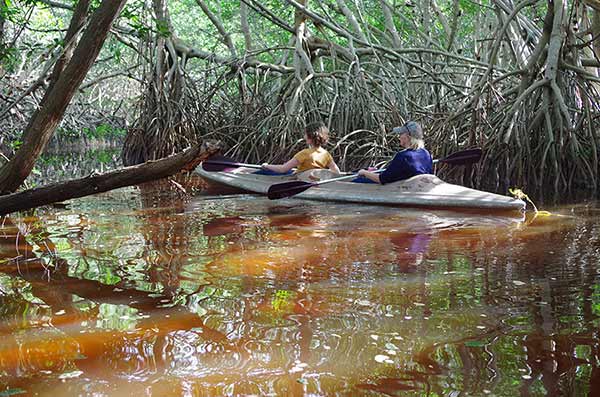
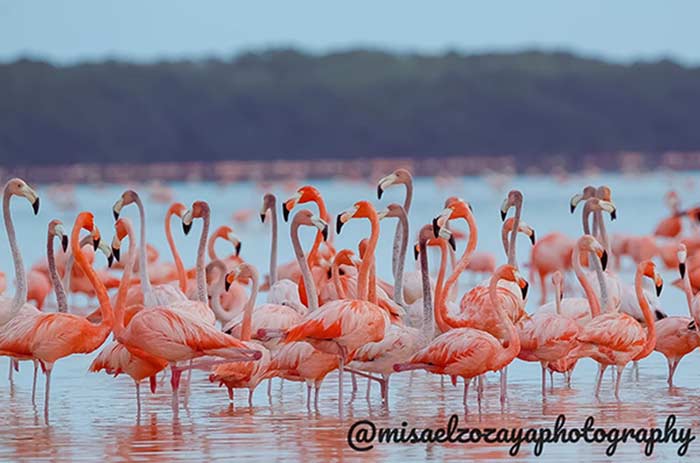
The drive from Merida to Celestun is about 65 miles (105 km), which makes it another of the ideal day trips from Merida. With the variety of activities, it’s easy to make this a full day out.
Celestun is a sleepy town, with the Gulf of Mexico on one side, and lagoons and swamps on the other. It lies on a narrow stretch of land surrounded by the Ría Celestún Biosphere Reserve.
Access to Celestun is via a road bridge, which acts as the departure point for the many boat trips into the lagoons and swamps. The boat trips are the main reason people visit Celestun.
Day trips from Merida to see Stunning Wildlife
You could see flamingos and some amazing exotic animals
In the biosphere, you may be fortunate enough to see up to 400 species of migratory birds – but not all at the same time! The main attraction is the flamingos. There always seem to be some flamingos around but in small numbers. That changes from December to February, -the Celestun flamingo season – when many thousands of these exotic pink birds arrive.
If you decide to stay longer and join some of the nature tours, you may see some of the 234 different mammal species of mammals that inhabit the biosphere. Although such sightings are rare, they include ocelots, jaguars, and spider monkeys. You might be ‘lucky’ enough to see crocodiles or even sea turtles! Click here for a list of possible fauna you might see.
Some trips can be done via kayak, through the mangrove swamps. These are great fun but make sure you are armed with strong mosquito repellent!
It’s worth mentioning that there are no banks in Celestun. I was happy to find an HSBC ATM.
On the seaward side of Celestun, you can walk along the beach. The town itself has many restaurants offering food at a range of prices. Seafood ranks high on the menu!
With so much wildlife to see (if you are there at the right time) a Celestun day trip from Merida is a great plan!
5. Izamal – the Yellow City with its own Mayan Pyramid
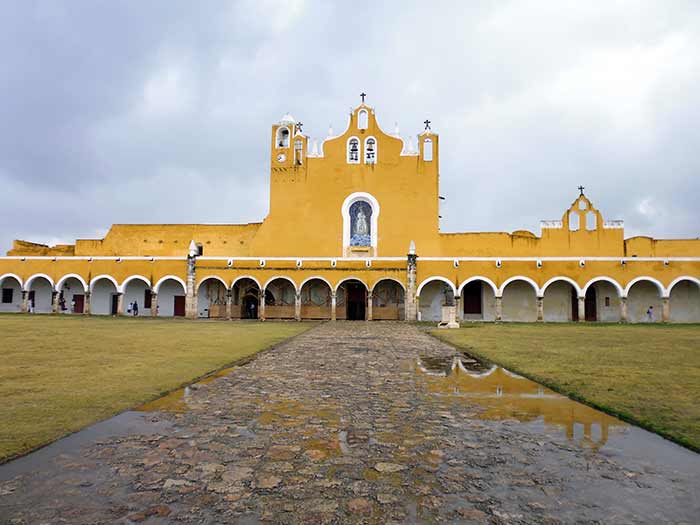
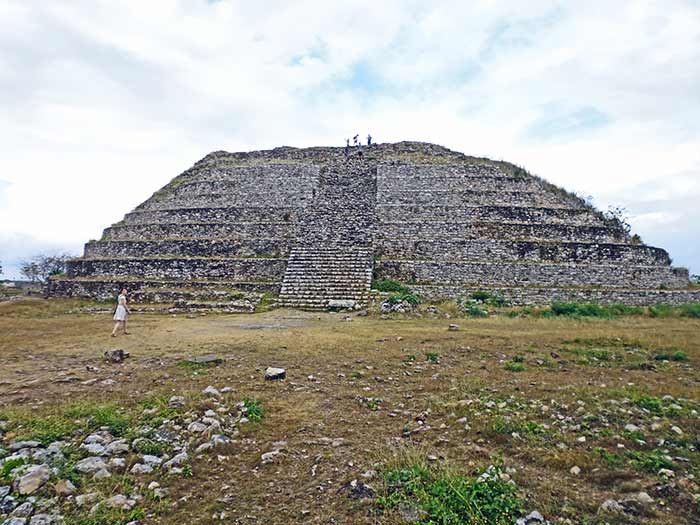
Merida to Izamal is another of the easy day trips from Merida as it’s only about 50 miles (70km).
Izamal is a Pueblo Magic. It was the first town assigned the designation, in 2001. Its outstanding features are the color of the buildings – yellow – and its climbable Mayan pyramid, Kincih Kak Moo.
Also known as Izamal, the yellow town, but why is Izamal yellow? There are various stories, ranging from the town being painted in honor of Pope John Paul II, a way of scaring away mosquitoes after a nasty infestation, or the yellow referring to the color of maize, which the Mayans hold as sacred. Basically, no one knows!
One of the most photographed yellow buildings is the former Convent of San Antonio de Padua, off the main square. With 75 arches, this complex has the largest closed atrium in the Americas. It was built on a Mayan temple.
Izamal is sometimes referred to as “the City of the Three Cultures”. As you wander the streets you’ll see evidence of its Mayan past, its Spanish heritage, and the modern Mexican influence. A popular way to see Izamal is from a horse-drawn carriage.
The City of Hills
The city is also called “the City of Hills” due to the five Mayan pyramids nearby. Until the Izamal ruins were uncovered, the locals thought they were just hills.
The largest of these is the Kinich Kakmó pyramid. At 110 feet (34 meters) high, this pyramid is one of the tallest to be found in the Yucatán state. It’s possible to climb the pyramid, which gives good views of the area but it’s not been restored like many Yucatan Mayan sites.
At the Izamal Cultural and Craft Center on the plaza, you’ll find a museum, gift shop, café, and craft center. Izamal has many restaurants serving local and other cuisines.
6. Uxmal – Better than Chichen Itza with fewer crowds
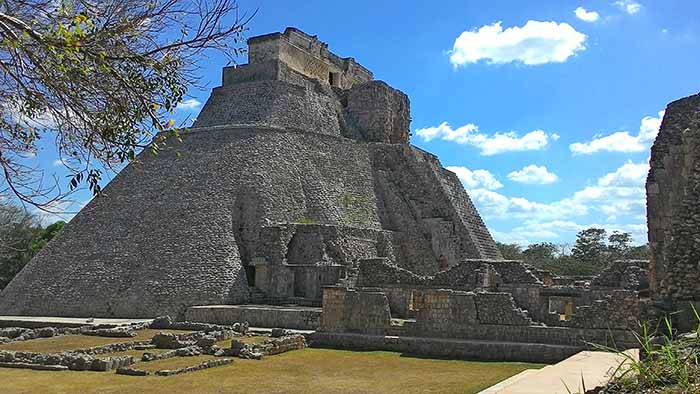
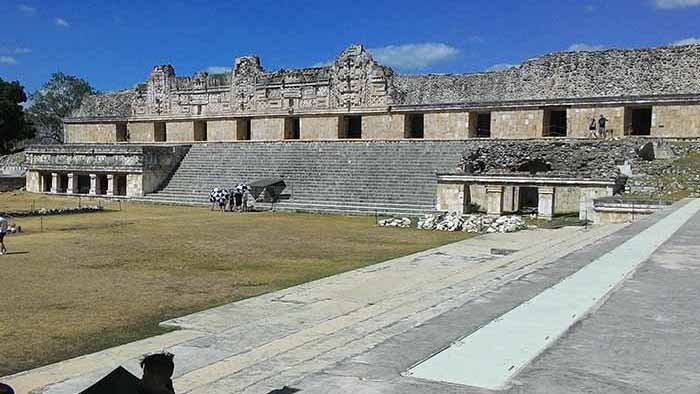
Uxmal is a UNESCO World Heritage Site, located about 50 miles (80km) from Merida. As day trips from Merida go, this is an ideal one if you’re interested in Mayan culture and ruins. Uxmal is a Mayan archaeological site that easily rivals or beats Chichen Itza for beauty and the quality of its renovated buildings.
Being slightly further from the Riviera Maya, it doesn’t attract the same crowds as Chichen Itza nor the pesky vendors.
Uxmal was probably first settled in the 7th Century but seems to have come in and out of influence a few times, so there are different building styles to be seen. Most have been restored with great care to give you a great feel for the way they looked in their prime. By 1573, when the Spanish first stumbled upon Uxmal, it was already deserted.
The ‘ruins’ of Uxmal consist of 15 structures and cover an area of 150 acres (60 hectares).
The tallest building is the Pyramid of the Diviner or Magician. Standing 115 feet (35 meters) high, its size and rounded shape make this the most impressive structure. You are not allowed to climb this monument.
The Great Pyramid stands opposite, on the other side of a large open area. It’s rectangular with a full-width, long flight of stairs going to the top. If you have the energy, you can climb the stairs – the view from the top is awesome.
The other 13 buildings deserve a look. There are courtyards where ball games were played, complete with the rings. Statues, along with carvings, abound making great photo opportunities.
It’s a large site, so you can get hot as you climb the stairs and explore the city. I recommend taking a hat, strong sunscreen, and ample water!
Ruta Puuc – the archeological route missed by most tourists
Uxmal marks the start of the Ruta Puuc, a 37- mile (60km) stretch of road that continues to the Loltún caves. The Ruta Puuc includes many archaeological sites, such as Kabah, Sayil, Xlapak, and Labna. Many others are not open to the public
For more information click Visiting Uxmal – Everything you need to know!
7. Two great Haciendas for day trips from Merida
The Yucatan is littered with haciendas, the fascinating remnants of a bygone era. These haciendas were the center of the massive henequin (sisal) trade that in the 19th Century provided the rope, rigging, and sacks that underpinned the world trade based on sailing ships before the invention of plastics. Some of the haciendas are in ruins but others have been restored, making great day trips from Merida. For me, the best haciendas near Merida are:
Hacienda San Pedro Ochil – a fascinating glimpse of the past
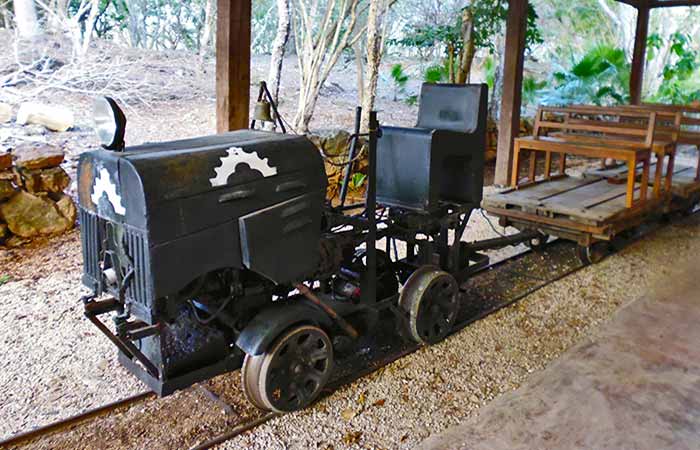
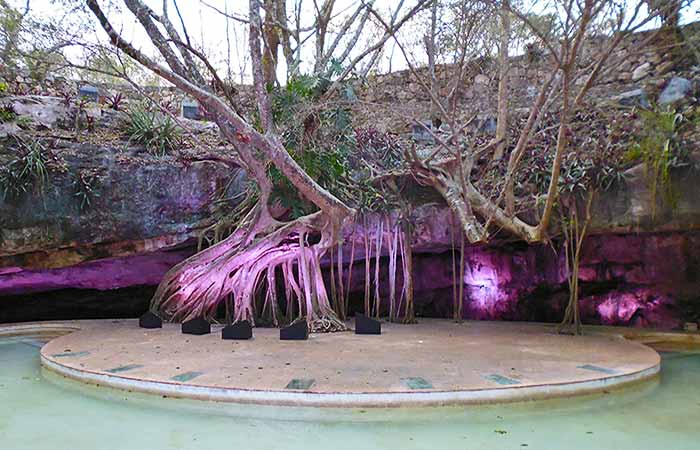
(March 2024 – a friend has just told me that when she visited Hacienda San Pedro Ochil it was closed and under new management.)
This hacienda is located only about 20 miles (32km) from Merida. It’s close enough to be combined with Uxmal as one of those day trips from Merida to remember! Hacienda San Pedro Ochil is a charming hacienda which some hidden extras. Aside from its architectural charm, with its Moorish arches, and pleasant gardens, it still has some of the original rail structure and machinery in place.
In the grounds is a small cenote in a small open-ended cavern that is the backdrop to a small amphitheater. Jardin Ochil is a new feature, with contemporary art reflecting the history and issues of the Yucatan on show.
The food features Yucatecan cuisine and is reasonably priced.
Hacienda Temozón – 5 Star luxury and great food
Hacienda Temezon is about the same distance from Merida as it’s only 8 miles (12km) from Hacienda San Pedro Ochil. This amazing Hacienda is now a luxurious 5-star hotel. There’s nothing extra to see here like at Hacienda San Pedro Ochil but we’ve taken visitors to the hacienda purely for the feeling of affluence.
The first record of Hacienda Temezon is from 1655. By the early 20th Century, it was one of the most important haciendas in Yucatán.
The plum-colored buildings are on two sides of a large lawned area. As you approach the main building with its 10 white-edged arches, the historical importance of the hacienda is evident. The hacienda has 28 rooms, a large garden (filled with bird songs whenever we have visited), and a 17th Century church.
The restaurant has lovely views over the garden and serves both traditional regional food and international cuisine. It is priced as one would expect for a 5-star hotel.
8. Valladolid –Visit this Hidden Gem with Character and History

Valladolid is a hidden gem, just off the major highway between Cancun and Merida, which means it’s often overlooked as a destination. The city merits one of your day trips from Merida as it has so much character and history. And, if you leave enough time, there are some great cenotes nearby.
The drive from Merida to Valladolid is an easy one along the highway. It’s about 2 hours by car. If you use the highway, note that there is a toll booth just before Valladolid which cost MXN223 (as at December 2023). This is a full day out but well worth the drive!
Undoubtedly, you’ll first arrive in the main square, whether you’re driving or taking a tour. The Plaza Mayor de Valladolid has been around since 1552. Today, it’s humming with activity and tourists. There are some souvenir shops and nice places to eat but it’s worth moving out of the square to see the ‘real’ Valladolid.
Off the main square, you’ll find Calzada de los Frailes. Dating back to the 16th Century, this is a quaint road that is filled with architecture, doorways, and colorful housing you’ll want to photograph.
Back at the main plaza, is the Iglesia de San Servicio (Cathedral San Gervasio).
About a ten-minute walk from the main plaza is the Mercado Municipal, the main market in Valladolid. This is open until around 1 pm and is the place to go to see an authentic Mexican market, with fruit and veg, butchers, handicrafts, etc. The sights and smells alone make it worth the walk. And there are many stalls to grab a bite.
One of the day trips from Merida you can’t miss.
Valladolid boasts several museums. The best of these is the Casa de Los Venados. This is a private house, with a stunning collection of Mexican folk art. You can only go on a guided tour. There are normally five a day. The cost is free but they ask for a donation of MXN100 which is donated to local charities. The tour takes about an hour but is well worth it.
At the far end of Calzada de los Frailes is Parque Sisal and the Convent of San Bernardino of Siena. It looks its age, which is about 500 years old but you can explore and get some nice snaps. If you can stay later in the evening there is a fascinating video mapping light show, in English!
(For those who can spend the night, we found the Real Hispano Hotel really good value and centrally located).
If you can only do one day trip from Merida and you are interested in culture and a different city vibe, rent a car and drive from Merida to Valladolid!
Learn more about Valladolid – 9 Great Reasons to Visit Valladolid
9. Rio Lagartos – see the Flamingos, Crocodiles and Pink Lakes!
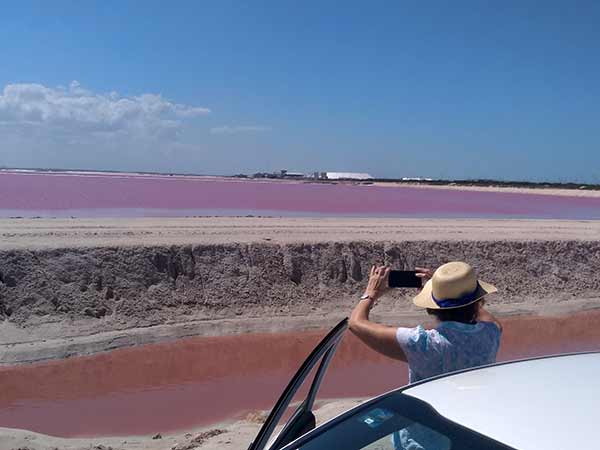
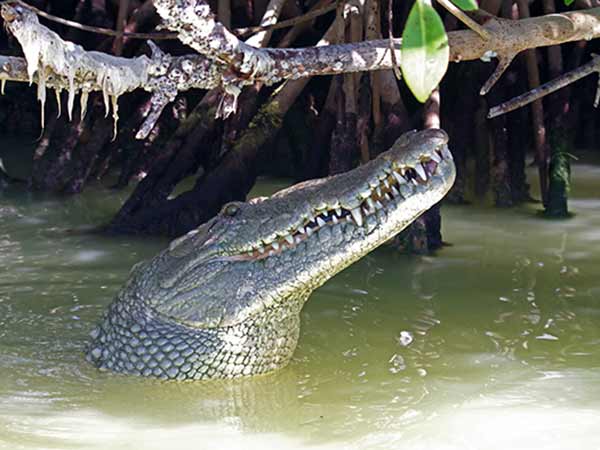
Río Lagartos is a small fishing village at the entrance to the Ría Lagartos, a semi-enclosed stretch of water.
This area is known for two things – a boat trip into the Río Lagartos Reserve to see the wildlife and Las Coloradas, the nearby pink lakes. It is possible to combine the boat trip with the pink lakes but we chose to drive to the lakes, giving us more flexibility.
The reserve is famous as a bird-watching spot due to the large number of migratory species that pass through, including many rarities. The most popular bird on people’s lists is the flamingo, which nests here. The flamingos in Celestun are not here all year round, so check before you visit.
Our boat trip was great fun. It was just the three of us and the captain. We saw many birds, got up close to a crocodile, and hand-fed frigate birds that swooped down to grab small fish from our fingers. We then went for a swim at the mouth of the estuary in the Gulf of Mexico. A really enjoyable morning.
Las Coloradas (the pink lakes) are really as pink as you see in photographs but this has a lot to do with the position of the sun – too early or late and the lakes will look rather dull.
Whether we were late or on the wrong day, we found many restaurants in Rio Lagartos closed by 8 pm.
Nearby is another small fishing town, San Felipe. The food at the oddly named Restaurante Vaselina was good food and reasonably priced.
Although we stayed overnight, several friends have done day trips from Merida to Rio Lagartos. It’s 134 miles (215 km) from Merida, taking under 3 hours each way.
10. Mayapan – Day trip to Mayan ruins without the crowds!
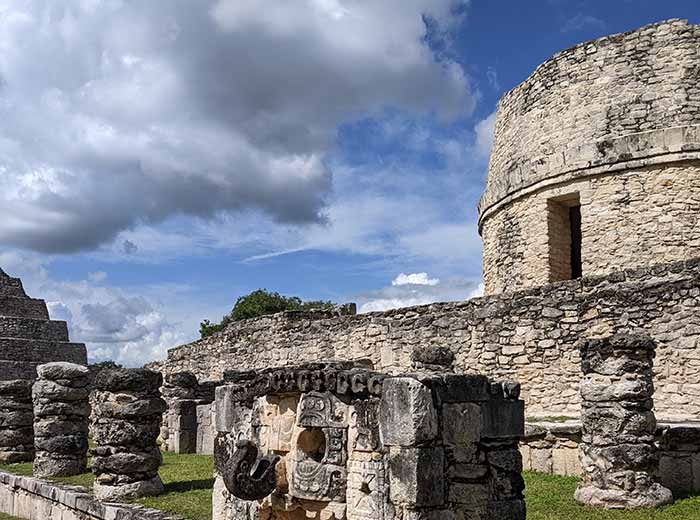
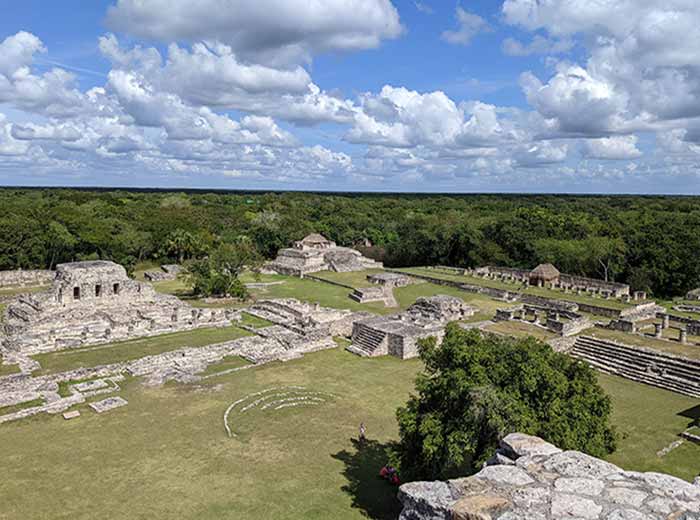
At just 28 miles (45km) from Merida, visiting the Mayapan Mayan ruins is a great day trip. The Mayapan ruins may not be as well renovated as those of Uxmal or Chichen Itza but it doesn’t suffer the crowds found at more popular sites.
Mayapan was looted and badly damaged in the mid-1400s, which has hampered the recent renovations. But you can still get a good feel of what the city was like, which makes a great day trip from Merida. The visitors we have taken have enjoyed the site, especially because there were no crowds.
The ancient city of Mayapán was built in the same style as Chichén Itzá. The main building is a pyramid, the Castle of Kukulcán, standing 60 feet (18m) high. This is like a smaller version it’s namesake at Chichen Itza.
Between the years 1200 and 1450 AD, Mayapán functioned as the capital of the northern part of the peninsula. The city once covered an area of about 1.5 square miles (4 km2).
At the time of writing, you can climb the ruins. This can be hot work. Since there is little cover at the site, bring a hat, sunscreen, and water.
To us, an outstanding feature is the frescoes, also known as the Mayapán murals. These still have the original colors. At many Mayan sites, you get used to just seeing the grey limestone blocks and can forget that some of these buildings were decorated with vibrant colors.
There is a town called Mayapan about 30 miles (48km) further away, so make sure you head to the correct place – the ‘Archaeological Zone of Mayapan’ or ‘Zona Arqueológica de Mayapan’ and not the town of Mayapan. For reference, the nearest town is Telchaquillo.
11. Chichen Itza – the iconic Mayan Ruin!
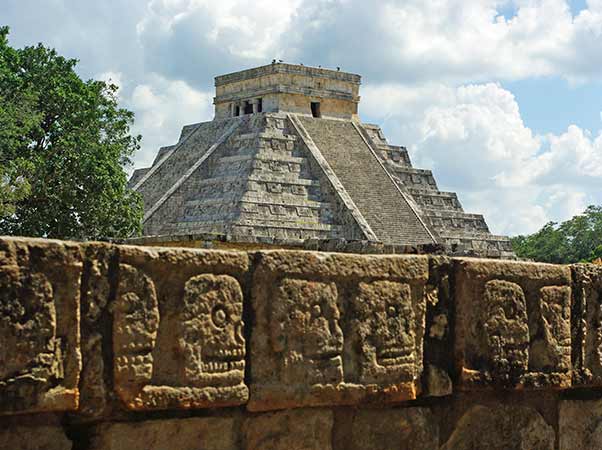
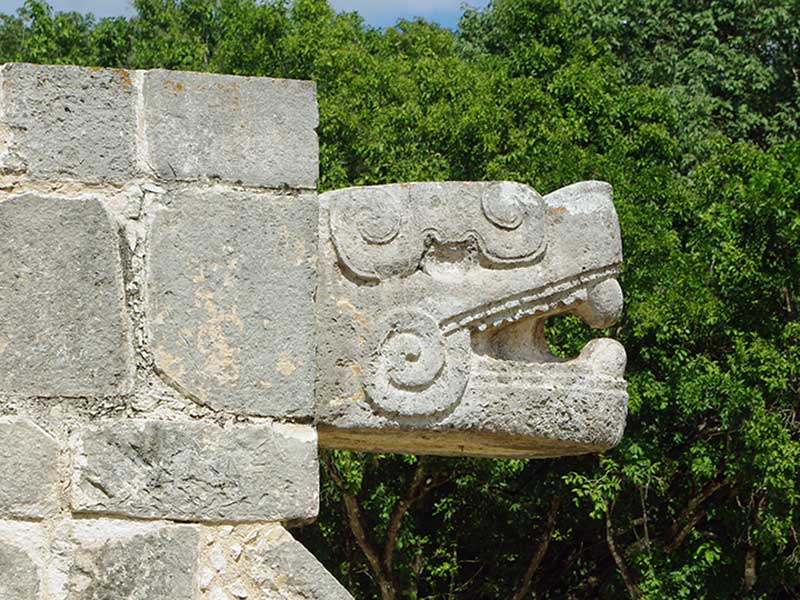
We’ve shown you 10 great day trips from Merida but the list of possibilities doesn’t end there! Here are two more:
On almost everyone’s list who visits the Yucatan is – Chichen Itza!
And for good reason. Chichen Itza is THE iconic Mayan Ruin in Mexico. It is a World Heritage Site and was voted one of the new Seven Wonders of the World.
Yes, it can get very crowded. Yes, it is one of the most expensive site to visit. But if you have the time, it is also one the largest and best preserved or restored Mayan ruins in the Yucatan Peninsula.
It’s an easy 90-minute to 2-hour drive from Merida to Chichen Itza. In 2024, you can take the Mayan train but for the best flexibility, driving yourself in a rental car is the best way to see Chichen Itza.
If you don’t have a car, you can get buses or taxis but that can work out expensive once you add the entrance fee. It’s also often more of a hassle. It’s easy to book a Merida to Chichen Itza tour at most of bigger Merida hotels or the numerous tours companies dotted about the city.
From Merida, it would be easy to combine Chichen Itza with a trip to Valladolid and make a full day trip of the journey. Driving back to Merida is safe, as most of the journey is on the recently refurbished 180 Federal Highway (one of good things from the Mayan Train?).
To make the best of your trip, with details of costs, what to see, the best time to visit and all the information you need to visit Chichen Itza, click here – Visiting Chichen Itza – and enjoying it!
12. Dzibilchaltun – Mayan ruins near Merida
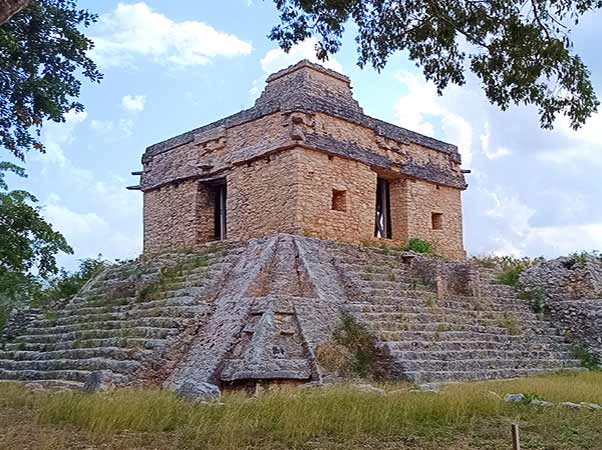
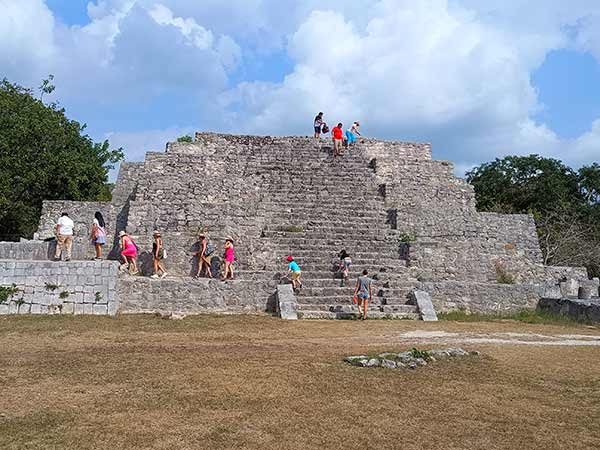
Another of the best day trips from Merida is this Mayan ruin!
At only 30 minutes from the center of Merida city, this is an ideal day trip. So if anyone asks if there are any Mayan ruins near Merida – the answer is ‘yes’ – Dzibilchaltun!
Dzibilchaltun Mayan ruins are a great alternative to either Chichen Itza or Uxmal. They are close enough, you can visit in the morning and be back in the city by lunch time.
Also, if you’re looking for cenotes near Merica, Dzibilchaltun is the location of Cenote Xlakah. This is an attractive cenote – but you can no longer swim in it.
One of the great attractions of Dzibilchaltun Mayan ruins is that you can climb on most of the pyramids and structures (but not all).
Among the other unique features of the nearby Mayan ruin is the Franciscan chapel built amidst the ruins by the Spaniards in the 1500s.
For more information click Everything you need to know about Dzibilchaltun.
13. Acanceh – more Mayan ruins near Merida
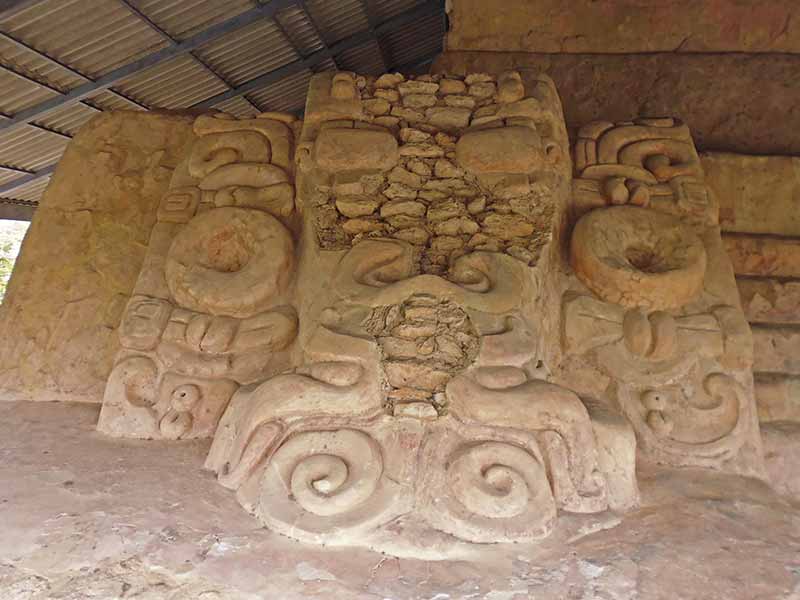
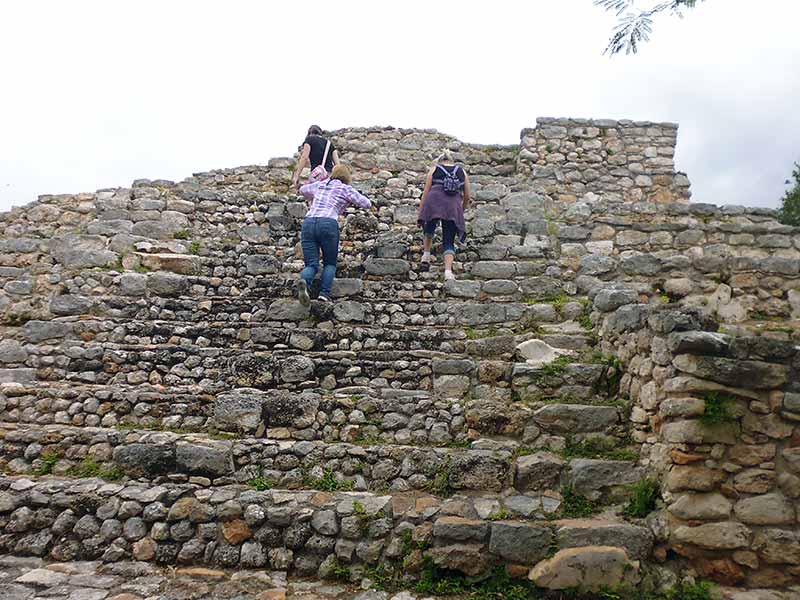
This is another great day trip from Merida as it can be combined with cenotes, haciendas or other Mayan ruins
At about 30 minutes from the center of Merida city, this is an easy day trip.
Acanceh ruins are small and not on the same scale as either Chichen Itza or Uxmal. But they are unique. Acanceh is probably the oldest continuous inhabited place in the Yucatan, if not further.
You can climb the pyramids and there are amazing friezes to be seen at the Palace of Stuccoes.
And another great thing – it doe snot get crowded. If there more people that you want, simply go to the town square – across the road from the ruins and have a drink. You’ll have the pyramids to yourself soon enough.
Acanceh itself is an interesting Mayan town worth a visit while you’re there.
For more information click The Complete Guide to Acanceh Mayan Ruins.
How to Rent a Car for your day trips from Merida
For each of these day trips, you can opt to travel by bus. There are the normal buses but for a few destinations, you can travel by ADO bus – a far more comfortable way to get around.
Renting a car in Merida is the best way to do your day trips if you want complete freedom to make spontaneous detours whenever something catches your eye.
Car rental in Merida is very easy. All the main car rental companies are represented, along with local rental companies you can find on Facebook.
First things first, make sure you have all the necessary documents in order: a valid driver’s license (international if needed) and proof of insurance. Once that’s sorted, it’s time to plan your route!
Plot out your itinerary beforehand using maps or navigation apps like Google Maps. I rely heavily on Waze, although occasionally it will choose a shortcut off the highways but these can lead to unexpected pretty villages you would otherwise never find.
Remember to factor in driving times and distances between locations so you can allocate enough time for each stop along the way. Don’t forget that Mexican roads may vary in quality, so be prepared for occasional bumps (quite literally!) Most of the highways are in good condition, as are the main secondary roads.
Before hitting the road, stock up on essentials such as water, snacks, sunscreen, and insect repellent. You’ll need a phone with a good data plan – you don’t want to run out of internet data miles from anywhere! It’s also wise to carry some cash for tolls and parking fees. (Tolls do NOT accept cards.)
Drive safely and have fun!
If you are driving in Mexico, read how to do it safely here: Essential tips for driving in Mexico
David H
After spending months in places like Playa del Carmen and Ajijic (near Lake Chapala, Guadalajara), my family and I have been living for the past four years in the Yucatan and enjoying this fabulous part of Mexico.
I've written many travel blogs for other travel sites over the years before starting Wonky Compass. I have three books published on Amazon.
Copyright 2024 www.wonkycompass.com